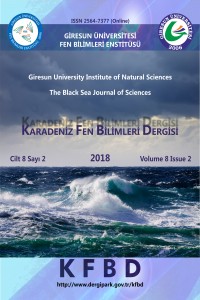Abstract
Phenolic compounds in the olive are very important because they affect the oxidative stability and sensory properties of the table olive. In this study, phenolic component and antioxidant capacities of Gemlik type olives collected from Fethiye district of Muğla in different ripening periods were investigated. Olive was collected during 4 times in 2-week periods. DPPH, ABTS, phenolic compound and flavonoid content changes were detected in the collected olives. The highest phenolic compound, flavonoid and ABTS amount were detected in olives collected during the 3rd period. (Respectively: 657.02 mg / 100 g catechin equivalent, 397.03 mg / 100 g catechin equivalent, 527.44 mg / 100 g Trolox equivalent). The highest amount of DPPH was found as 20,41 mg / 100 g Trolox equivalent in olives collected in the 1st period.
Keywords
References
- Brand, W., Cuvelier, MC., Berset, C., (1995). Use of the free radical method to assess antioxidant activity. Food Sci. Technol. 28, 25-30.
- Demir, D., (2013). Zeytinde Polifenol Oksidaz Enzimi, ZZ Review, Isparta, 29,68-73.
- Fernandez-Orozco R, Roca M, Gandul-Rojas B, GallardoGuerrero L., (2011). DPPH-scavenging capacity of chloroplastic pigments and phenolic compounds of olive fruits (cv. Arbequina) during ripening. J Food Compos Anal. 24,858-864.
- Kadakal, E., (2009). Gemlik Yöntemi İle İşlenmiş Gemlik Tipi Sofralık Zeytinleri Antioksidan Özellikleri Ve Fenolik Profilleri, Yüksek Lisans Tezi, İstanbul Teknik Üniversitesi, Fen Bilimleri Enstitüsü, İstanbul.
- Karadeniz, F., Burdurlu, H., Koca, N., Soyer, Y., (2005). Selected Grown Fruits and vegetables Antioxidant Activity in Turkey, Turkish Journal of Agriculture and Forestry, 29,297-303.
- Kaya, Ü. ve Mutlu, T.K., (2010). İznik’te Yetiştirilen Gemlik Zeytininin ve Yağının Bazı Fiziksel, Kimyasal ve Antioksidan Özelliklerinin Belirlenmesi. CU Institute of Science and Technology, 22-1.
- Keçeli, T. and Büyükaslan, Y., (2008). Hatay’da Yetiştirilen Bazı Zeytinlerin Antioksidan Etkilerinin Belirlenmesi. Türkiye 10. Gıda Kongresi. Turkey, Mayıs 21-23, Erzurum.
- Pirgün, Y. and Keçeli, T., (2008). Hatay’da Yetiştirilen Gemlik ve Halhalı Zeytinlerinin Antioksidan Etkilerinin Belirlenmesi. CU Institute of Science, 18-1.
- R Re, N., Pellegrini, A., Proteggente, A., Pannala, M., Yang, C., (1999). Antioxidant activity of applying a colorimetric assay of an improved ABTS radical cation. Free Radical Biology and Medicine, 26,1231-1237.
- Tokuşoğlu, Ö., (2008). Sofralık Zeytinlerde, Zeytiyağında, Zeytin Ürünlerinde Ve Zeytin Karasuyunda Antioksidan Etkili Polifenoller Ve Biyoaktif Bileşiklerin Eldesinde Nanoteknoloji Uygulamaları, I. Ulusal Zeytin Öğrenci Kongresi, Edremit-Balıkesir.
- Yemişçioğlu, F., Gümüşkesen, A.S., Otağ, R.M., (2001). Zeytinyağı üretiminde kullanılan sürekli sistemler ve bu sistemlerin klasik presleme yöntemi ile karşılaştırılması. TMMOB Gıda Mühendisliği Dergisi, 9, 26–31.
Gemlik Tipi Zeytinlerin Olgunlaşma Dönemindeki Fenolik, Flavonoid ve Antioksidan Kapasitesindeki Değişiklikler
Abstract
Bu çalışmada, Muğla Fethiye ilçesinde farklı olgunlaşma dönemlerinde toplanan Gemlik tipi zeytinlerin fenolik bileşenleri ve antioksidan kapasiteleri incelenmiştir. Zeytin 2 haftalık periyotlarda 4 kez toplandı. Toplanan zeytinlerde DPPH, ABTS, fenolik bileşik ve flavonoid içerik değişiklikleri tespit edildi. En yüksek fenolik bileşik, flavonoid ve ABTS miktarı, 3. periyotta toplanan zeytinlerde tespit edildi (sırasıyla; 657.02 mg / 100 g kateşin eşdeğeri, 397.03 mg / 100 g kateşin eşdeğeri, 527.44 mg / 100 g Trolox eşdeğeri). Birinci periyotta toplanan zeytinlerde DPPH'nin en yüksek miktarı 20,41 mg / 100 g Trolox eşdeğeri olarak bulundu.
Keywords
References
- Brand, W., Cuvelier, MC., Berset, C., (1995). Use of the free radical method to assess antioxidant activity. Food Sci. Technol. 28, 25-30.
- Demir, D., (2013). Zeytinde Polifenol Oksidaz Enzimi, ZZ Review, Isparta, 29,68-73.
- Fernandez-Orozco R, Roca M, Gandul-Rojas B, GallardoGuerrero L., (2011). DPPH-scavenging capacity of chloroplastic pigments and phenolic compounds of olive fruits (cv. Arbequina) during ripening. J Food Compos Anal. 24,858-864.
- Kadakal, E., (2009). Gemlik Yöntemi İle İşlenmiş Gemlik Tipi Sofralık Zeytinleri Antioksidan Özellikleri Ve Fenolik Profilleri, Yüksek Lisans Tezi, İstanbul Teknik Üniversitesi, Fen Bilimleri Enstitüsü, İstanbul.
- Karadeniz, F., Burdurlu, H., Koca, N., Soyer, Y., (2005). Selected Grown Fruits and vegetables Antioxidant Activity in Turkey, Turkish Journal of Agriculture and Forestry, 29,297-303.
- Kaya, Ü. ve Mutlu, T.K., (2010). İznik’te Yetiştirilen Gemlik Zeytininin ve Yağının Bazı Fiziksel, Kimyasal ve Antioksidan Özelliklerinin Belirlenmesi. CU Institute of Science and Technology, 22-1.
- Keçeli, T. and Büyükaslan, Y., (2008). Hatay’da Yetiştirilen Bazı Zeytinlerin Antioksidan Etkilerinin Belirlenmesi. Türkiye 10. Gıda Kongresi. Turkey, Mayıs 21-23, Erzurum.
- Pirgün, Y. and Keçeli, T., (2008). Hatay’da Yetiştirilen Gemlik ve Halhalı Zeytinlerinin Antioksidan Etkilerinin Belirlenmesi. CU Institute of Science, 18-1.
- R Re, N., Pellegrini, A., Proteggente, A., Pannala, M., Yang, C., (1999). Antioxidant activity of applying a colorimetric assay of an improved ABTS radical cation. Free Radical Biology and Medicine, 26,1231-1237.
- Tokuşoğlu, Ö., (2008). Sofralık Zeytinlerde, Zeytiyağında, Zeytin Ürünlerinde Ve Zeytin Karasuyunda Antioksidan Etkili Polifenoller Ve Biyoaktif Bileşiklerin Eldesinde Nanoteknoloji Uygulamaları, I. Ulusal Zeytin Öğrenci Kongresi, Edremit-Balıkesir.
- Yemişçioğlu, F., Gümüşkesen, A.S., Otağ, R.M., (2001). Zeytinyağı üretiminde kullanılan sürekli sistemler ve bu sistemlerin klasik presleme yöntemi ile karşılaştırılması. TMMOB Gıda Mühendisliği Dergisi, 9, 26–31.
Details
| Primary Language | Turkish |
|---|---|
| Subjects | Engineering |
| Journal Section | Articles |
| Authors | |
| Publication Date | December 31, 2018 |
| Published in Issue | Year 2018 Volume: 8 Issue: 2 |

This work is licensed under a Creative Commons Attribution-NonCommercial-ShareAlike 4.0 International License.


